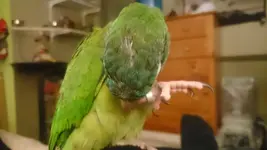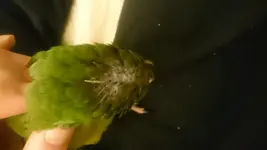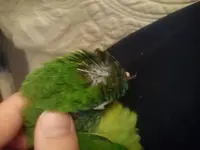BAMM17
New member
- Oct 21, 2017
- 23
- 0
- Parrots
- "Rudra" - Green Budgerigar; M |
"Nayru" - Blue Crowned Conure; M
My BCC is currently undergoing a somewhat minor molt; fair amount of pin feathers around the neck and on his head and face.
For the most part it appears normal to me, however on the top of his head there is a large featherless spot, and while pin feathers are growing in place, the skin underneath and the size of the spot seems like a possible symptom of something. I have attached pictures to the thread.
We will be visiting the vet next week, for this and a few other skin/feather related issues, however I want to determine if any other parrot owners have encountered similar symptoms? And if so what were some of the causes?
One possibility I'm aware of is the humidity level in the room. My gauge typically reads between 10-20% which is pretty dry, so perhaps dry skin is causing some of the issues I am seeing? Hopefully we can rule out bacterial/fungal/allergy issues when we visit our vet.
Could also be a dietary issue maybe? He eats RoudyBush Maintenance and Nutriberries as a base diet, and each morning I serve a variety of fruits & vegetables, but are there any specific foods that should be offered during molting to prevent "stress bar", malnourished feathers, etc.?
Thank you for any insight you can provide.



For the most part it appears normal to me, however on the top of his head there is a large featherless spot, and while pin feathers are growing in place, the skin underneath and the size of the spot seems like a possible symptom of something. I have attached pictures to the thread.
We will be visiting the vet next week, for this and a few other skin/feather related issues, however I want to determine if any other parrot owners have encountered similar symptoms? And if so what were some of the causes?
One possibility I'm aware of is the humidity level in the room. My gauge typically reads between 10-20% which is pretty dry, so perhaps dry skin is causing some of the issues I am seeing? Hopefully we can rule out bacterial/fungal/allergy issues when we visit our vet.
Could also be a dietary issue maybe? He eats RoudyBush Maintenance and Nutriberries as a base diet, and each morning I serve a variety of fruits & vegetables, but are there any specific foods that should be offered during molting to prevent "stress bar", malnourished feathers, etc.?
Thank you for any insight you can provide.



